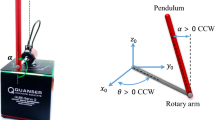Abstract
The anti-swing radial basis neuro-fuzzy LQR (RBNFLQR) controller for a multi-degree-of-freedom (DOF) rotary inverted pendulum is developed in this paper. One of the major challenges is to design an anti-swing RBNFLQR controller that has high precision, robustness, and vibration suppression to control the multi-DOF rotary inverted pendulum system. The study here demonstrates a novel RBNFLQR controller in which the positions and velocities of state variables multiplied by the LQR gains are tuned using the radial basis neural networks (RBNNs) architecture. The outputs of the RBNN are fuzzified by the fuzzy controller to obtain the desired torque of the pendulum systems. The RBNN based on the Bayesian regularization (BR) algorithm is able to self-adjust the LQR gains of the state variables. In order to stabilize the pendulums to zero positions more effectively, the tuned gains of LQR help to reduce the aggressiveness of the fuzzy control rules. The control performance of the anti-swing RBNFLQR controller was verified by simulation and experimental results in two, three, and four DOF rotary inverted pendulum systems. The proposed controller exhibits robustness to external disturbances and has much better vibration suppression capability. The present work provides a novel and effective framework to develop an anti-swing RBNFLQR controller for multi-DOF pendulum systems.











Similar content being viewed by others
Data availability
The datasets generated during and/or analyzed during the current study are available from the corresponding author on reasonable request.
References
El-Nagar Ahmad M et al (2014) Intelligent control for nonlinear inverted pendulum based on interval type-2 fuzzy PD controller. Alex Eng J 53(1):23–32
Al-Mahturi A et al (2019) An intelligent control of an inverted pendulum based on an adaptive interval type-2 fuzzy inference system. In: IEEE international conference on fuzzy systems (FUZZ-IEEE). IEEE
Faizan J et al (2021) Comparative analysis of modern control schemes in improved dynamics of inverted pendulum. In: India Council international conference (INDICON). IEEE
Mukhtar Fatihu H, Hwa Jen Y, Imtiaz Ahmed C et al (2019) Current development on using rotary inverted pendulum as a benchmark for testing linear and nonlinear control algorithms. Mech Syst Signal Process 116:347–369
Brisilla RM, Sankaranarayanan V (2015) Nonlinear control of mobile inverted pendulum. Robot Auton Syst 70:145–155
Vicente C, José A, Julián S et al (2016) Control of the rotary inverted pendulum through threshold-based communication. ISA Trans 62:357–366
Qifeng W, Dayawansa WP, Levine WS (1995) Nonlinear controller for an inverted pendulum having restricted travel. Automatica 31(6):841–850
Igor A, Nikolay A (2012) Control of a multi-link inverted pendulum by a single torque. IFAC Proc Vol 45(2):550–553
Khaled Gamal E et al (1999) Nonlinear generalized equations of motion for multi-link inverted pendulum systems. Int J Syst Sci 30(5):505–513
Hazem ZB, Fotuhi MJ, Bingül Z (2020) A comparative study of the joint neuro-fuzzy friction models for a triple link rotary inverted pendulum. IEEE Access 8:49066–49078
Hazem ZB (2021) Anti swing up control of a single, double and triple link rotary inverted pendulum with nonlinear friction models. Doctoral thesis
Solihin MI, Wahyudi, Legowo A (2010) Fuzzy-tuned PID anti-swing control of automatic gantry crane. J Vib Control 16(1):127–145
Zuo XQ, Fan YS (2006) A chaos search immune algorithm with its application to neuro-fuzzy controller design. Chaos Solitons Fractals 30(1):94–109
Pouria T, Ramin V (2018) Adaptive critic-based quaternion neuro-fuzzy controller design with application to chaos control. Appl Soft Comput 70:622–632
Bhangal NS (2013) Design and performance of LQR and LQR based fuzzy controller for double inverted pendulum system. J Image Graph 1(3):143–146
Usman R, Mohsin J, Syed Omer G et al (2015) LQR based training of adaptive neuro-fuzzy controller. In: International workshop on neural networks. Springer, Cham, pp 311–322
Hazem ZB, Fotuhi MJ, Bingül Z (2020) Development of a fuzzy-LQR and fuzzy-LQG stability control for a double link rotary inverted pendulum. J Frankl Inst 357:10529–10556
Hazem ZB, Fotuhi MJ, Bingül Z (2021) A study of anti-swing fuzzy LQR control of a double serial link rotary pendulum. IETE J Res. https://doi.org/10.1080/03772063.2021.1911690
Hazem ZB, Fotuhi MJ, Bingül Z (2022) Anti-swing radial basis neuro-fuzzy linear quadratic regulator control of double link rotary pendulum. Proc Inst Mech Eng Part I J Syst Control Eng 236(3):531–545
Jin Seok N, Geun Hyung L, Seul J (2010) Position control of a mobile inverted pendulum system using radial basis function network. Int J Control Autom Syst 8(1):157–162
Moawad NM, Elawady WM, Sarhan AM (2019) Development of an adaptive radial basis function neural network estimator-based continuous sliding mode control for uncertain nonlinear systems. ISA Trans 87:200–216
Kayri M (2016) Predictive abilities of Bayesian regularization and Levenberg–Marquardt algorithms in artificial neural networks: a comparative empirical study on social data. Math Comput Appl 21(2):20
Kadkhodaie-Ilkhchi A, Rezaee MR, Rahimpour-Bonab HA (2009) committee neural network for prediction of normalized oil content from well log data: an example from South Pars Gas Field, Persian Gulf. J Pet Sci Eng 65(1–2):23–32
Acknowledgements
The authors would like to thank the Scientific Research Projects Coordination Unit (SRPCU) of Kocaeli University for the experimental setup support. SRPCU Number is “2018/071.”
Author information
Authors and Affiliations
Corresponding author
Ethics declarations
Conflict of interest
No potential conflict of interest was reported by the authors.
Additional information
Publisher's Note
Springer Nature remains neutral with regard to jurisdictional claims in published maps and institutional affiliations.
Rights and permissions
Springer Nature or its licensor (e.g. a society or other partner) holds exclusive rights to this article under a publishing agreement with the author(s) or other rightsholder(s); author self-archiving of the accepted manuscript version of this article is solely governed by the terms of such publishing agreement and applicable law.
About this article
Cite this article
Ben Hazem, Z., Bingül, Z. A comparative study of anti-swing radial basis neural-fuzzy LQR controller for multi-degree-of-freedom rotary pendulum systems. Neural Comput & Applic 35, 17397–17413 (2023). https://doi.org/10.1007/s00521-023-08599-6
Received:
Accepted:
Published:
Issue Date:
DOI: https://doi.org/10.1007/s00521-023-08599-6




